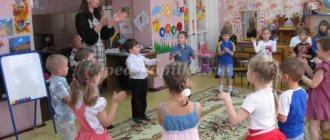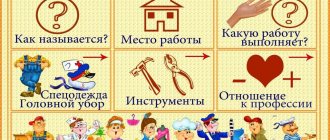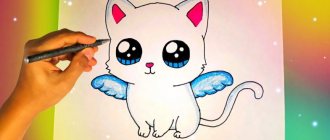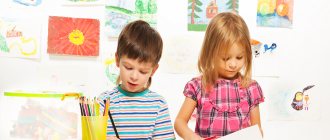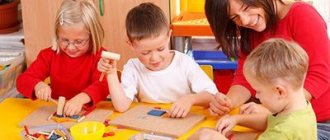On the topic: methodological developments, presentations and notes
Objectives of the lesson: - to clarify children’s knowledge about grain growers, bread and its path to our table; - to continue enriching the vocabulary, the formation of grammatical structure, the development of coherent speech; - to cultivate a caring attitude.
I bring to your attention a summary of a lesson I conducted in a senior speech therapy group.
Summary of a subgroup speech therapy lesson in the senior group. Lexical topic: “Autumn. Trees.".
Summary of a subgroup speech therapy lesson in the senior group. Lexical topic: “Autumn. Trees.".
Summary of a subgroup speech therapy lesson in the senior group Lexical topic “New Year”. Sounds k, k. Automation of sound w. Correctional and educational goals. Consolidation.
Consolidating the correct pronunciation and distinction of sounds [р] [р'] in words.
Summary of a subgroup speech therapy lesson in the senior group on the topic: “Winter. New Year holiday".
Progress of the lesson
Introduction
The teacher asks the children to take their seats. Cheerful music is playing. The teacher says: “It seems that an unusual guest came to us today. Please look what he left in the locker room (takes out a frying pan)! Who do you think came to see us today?” Children offer their options (cook, Maslenitsa, Kolobok).
The teacher shows them an illustration for Marshak’s poem “He’s so absent-minded” and reads the poem. Then she asks: “What did the frying pan turn out to be for the Absent-Minded One? That's right, a headdress. Of course, he put it on his head instead of a hat by mistake. Let’s correct his mistake and remember everything that can be put on your head in different seasons.”
Game "On my head"
Children pass the ball to each other and name the hats, saying: “On my head...”. Everyone answers in turn. The winner is the one who remembers the required name last.
The topic of hats has already been encountered in the course program on speech development in the senior group, so this lesson reinforces the material.
Game "Guess what's on my head"
The teacher says: “You remembered and named many different hats, and now we will try to guess the one that each of you sees in the picture.” Then she lays out subject cards with hats in front of her, calls each child, asks them to choose one of the illustrations, but not name it. The child is asked to tell about the hidden object. Other children must guess the wardrobe item in question.
Articulation gymnastics
The teacher invites the children to rest a little on their own, but do gymnastics for the tongue according to the fairy tale “At Grandma and Grandpa’s.”
Conversation on the painting “Where does the shirt come from”
The teacher shows the picture, the children look at the illustration.
Then the teacher asks: “Tell me, what professions do people make clothes?” Children list their specialties: weaver, seamstress, fashion designer, cutter. The teacher clarifies about each of them:
- What is this employee doing?
- Why is he doing this?
- Where is his workplace?
- What tools help him work?
“Why are there people in the picture collecting something in a field? Do clothes grow in the field? Children answer, the teacher complements the story about cotton (with a demonstration of a cotton boll, as well as cotton fabric).
Making a story with pictures
The teacher takes one picture from the series for a speech therapy lesson on the topic Clothing. Then he discusses with the group what is drawn on it. Children complete the story. All pictures are laid out in order. Then they are mixed and the teacher invites someone to arrange them again, repeating the story in full.
Game “Sew clothes for a bear”
Everyone sits in a circle. The teacher invites everyone to pass a piece of cotton fabric to each other, naming the clothes that could be sewn from it for a teddy bear.
Learning and repeating tongue twisters
The teacher asks you to remember tongue twisters about clothes. Offers several for memorization. For example:
Cuckoo bought a hood. The cuckoo put on his hood - How funny he is in the hood!
Fizminutka
It is held at the table.
- They collected the cotton together (we actively move our hands, “collecting” the boxes)
- We wove fabric from it (we move it back and forth with both hands, simulating the operation of a loom)
- They cut it out. (“cut” with scissors)
- We will sew, (“we scribble” on a typewriter)
- So that everyone can wear new clothes! (hands on waist, slightly turn to the sides)
For any speech therapy lesson in the senior and preparatory groups, it makes sense to select poems that are appropriate in meaning for the physical education break.
Getting to know the mnemonic table
Educator: “Now you and I will play riddles. Here is a hint table that will help us. Let's take a close look at the small drawings that are on it. If I want to talk about this winter hat, then the table will not let me forget anything!”
The teacher writes a short description about the winter hat, based on pictograms. (This is put on the head, this is a headdress - Everyone wears it - We wear such a headdress in the cold season - It is knitted from wool, it is warm - This thing is multi-colored, with stripes). Then the teacher offers to play with the pictures and table.
Game “Describe and Guess”
The teacher lays out pictures with images of clothing items. Children (one by one) approach the table, each of them opens one picture, describes the image, but does not name it. The rest guess what the presenter saw.
Game "Clothes for work"
The teacher tells the group that people of different professions dress in a special way at work. Then she asks everyone to divide into subgroups, gives each of them one card depicting the attributes of the profession, as well as a complete set of pictures of different items of clothing. Each group selects the necessary cards from the set. At the end of the game, the teacher shows everyone the selected items of clothing for each specialty, everyone discusses the correct selection of cards.
A moment of poetry
Educator: “We talked about the clothes that people wear at work. What kind of clothing does someone who stands outside all day in winter need? What if it’s not a person, but a snow woman? Does she need to be dressed? The children answer, and then the teacher reads S. Cherny’s poem “The Snow Woman” and asks them to answer the questions:
- Why did the boy decide to take out clothes for the snow woman?
- What did he choose for her?
- How did he dress himself to go out?
- What will happen in the morning?
- What would you say to a boy if you were the snow woman?
Game "Let's go for a walk"
The whole group sits in a circle. Children pass the ball to each other, naming items of winter clothing, winter shoes, and hats.
The lesson ends. The teacher thanks everyone for their answers, once again reminds them of the topic of the last lesson, and offers an assignment for home (draw yourself or someone else in your favorite clothes).
This lesson summary may be useful for speech therapists, as well as teachers involved in the development of speech of children in the senior group of kindergarten. Some of the exercises may be useful for parents whose children attend a speech therapy group.
Summary of a lesson in a senior speech therapy group on the topic: Clothing
"Miracle Tree"
Compiling a descriptive story on the topic “Clothing” in the CI group for children with SLI from 5 to 6 years old. Goal: To consolidate in children the ability to compose descriptive stories on the topic “Clothing” Objectives: Speech development: enrich and activate the vocabulary on the topic “Clothing”, develop coherent speech, learn to compose descriptive stories about clothing according to plan, improve the grammatical structure of speech, teach to form relative adjectives.
Cognitive development: consolidate the ability to determine the material from which an object is made, develop attention, memory, logical thinking, cultivate a caring attitude towards clothing. Physical development: develop gross and fine motor skills Artistic and aesthetic development: develop the ability to listen carefully to a poem, be able to share impressions about what you read earlier, comment on the actions of a literary character. Social and communicative development: to cultivate in children a tolerant attitude towards each other, skills of cooperation, and mutual understanding. Progress of the lesson:
Introduction: Speech therapist: -Every new day should be started in a good mood.
Let's stand in a circle, hold hands, close our eyes and pass on to each other that spark of warmth and love that lives in our hearts. Now let's open our eyes and smile at each other. I see that everyone is in a good mood. Main part:
1. The children, together with the speech therapist, approach the screen.
Speech therapist: -Listen to the poem: How a Miracle Tree grows at our gate. Miracle, miracle, miracle, wonderful miracle! Not leaves on it, Not flowers on it, But stockings and shoes, Like apples! An image of a tree appears on the screen.
-Guys, do you know the name of this poem? (Miracle tree) -Who wrote it? (K. Chukovsky) - Guys, if this is a miracle tree, how can you tell about it what it is? (Fairy-tale, magical). - Yes, guys, that’s why sometimes objects on it disappear, and new ones appear in their place. Look - they've disappeared. Only for some reason new objects did not appear on it, and the tree itself shrank. He must have run out of all his magical power. Do you want to help him? To do this you need to complete tasks. 2.-Do you want to know what objects should have appeared on the tree? To do this you need to solve riddles. Two trouser legs and an elastic band - A very strange picture. Where is the back and where is the front? Who will figure it out right away? (pants) So as not to freeze, Five guys are sitting in a knitted stove. (Mittens) Maybe it’s straight, Maybe it’s flared. Can be any color, Red and green. May have folds, lace, frills. Grandmothers, women and girls wear it. (skirt) It warms your neck in the cold winter, Soft, fluffy and woolen. (scarf) I’m like an umbrella - I don’t get wet, I protect you from the rain And I’ll cover you from the wind, Well, what am I? (cloak)
- How can all these objects be called in one word? Clothes This means that clothes should have appeared on our tree. But she didn’t appear because the tree’s power had dried up. We'll have to look for clothes ourselves. Where do people buy clothes? (In the store.) -We go to the store, and along the way we will complete tasks to help the tree. 3.D/I “Tsvetik-varitsvetik” -Look at what an unusual flower - a colorful one. Let's take a closer look at it. Sit comfortably on the mat. -What are its petals made of? (Fabric) What color are the fabrics? - Why do people need fabric? Let everyone take a petal that he likes. Tell us what this fabric is called and what can be sewn from it. — This is jeans, you can make a denim shirt from it, etc. - Well done guys, let's attach our petals to the board so that we get a flower again. - Look, it seems to me that our tree has grown a little, it probably has a little more magical power.
4.-And now, we will play with you the game “Assemble the clothes.” Each child is given pieces of clothing. The speech therapist asks what they are called. Children walk in a circle and read the poem: Clothes have pockets, sleeves and a collar, A lock, shelves, cuffs - it’s a down jacket! Children run up to the board and assemble a jacket from the parts. It’s so good that you were able to complete the task so quickly and we can move on. And our tree has grown a little more.
5.D/I “Magic bag” - Oh, what is this worth here? Some kind of bag. I wonder what's inside? This is probably our next task. Come closer, put your pen in the bag and try to guess who got what clothes. And then name whether these clothes are men’s, women’s or children’s. (Children attach items of clothing to the board) - All the guys completed the task correctly. Look, our tree has become almost the same as it was before. 6.-Who is this sitting here? A doll in wrinkled and dirty clothes sits on the table - Don’t you know? I think I guessed it. This is a boy from another work by Chukovsky. -What is the name of this poem? (Moidodyr) -What happened to him? Children: He was dirty and didn’t want to wash. -Look at his clothes. What is she like? Dirty, wrinkled. Let's tell him how to properly care for her. Those children who choose a picture with a palm will tell them what to do with the clothes, and those whose palm is crossed out will say what is not allowed. Children attach a picture of palms to the board. -And now we will help our dirty guy.
7. Physical Minute We poured water into a basin and soaked the clothes, washed them with soap, washed them, rinsed them thoroughly, and now we’ll wring everything out, shake them well, hang them on a rope, and deftly snap the clothespin! And if it dries out, what then? Let's iron everything! (children perform imitative movements)
-Well, look at our dirty little guy - how clean and neat he has become! -And our miracle tree has become big and beautiful again! Go ahead. 8.-Here is the store. I will be the seller, and you will be the buyers. And in order to buy clothes, you need to come up with a story about your clothes, and our pictures that we attached to the board will help you. (Having completed all the tasks, the children drew up a diagram of a descriptive story) Children take turns coming up, choosing a picture with the clothes they like and making up descriptive stories.
-Guys, you did a very good job, your stories were very interesting. And you were able to buy clothes for the tree. 9.-Our tree is ready to show us its magic. Smile at each other, And the clothes appear. After all, our smiles are a real miracle! Let's all get together! Children wave their hands, clothes appear on the tree.
Result: - Guys, what an interesting activity we had today! -What games did you like to play? -What interesting things did you learn in class? -What was difficult? -Who will you tell about our lesson? -The miracle tree thanks you for helping it and is waiting for you next time, with new miracles. It gives you a miracle bush. You will take him to the group, take some candy for yourself and treat the rest of the guys in your group.
We recommend watching:
Summary of a psychological and speech therapy lesson in a senior speech therapy group. Summary of an individual educational activity with a 5-6 year old pupil for the correction of sound pronunciation. Summary of an educational activity in a senior speech therapy group. Summary of a lesson in a senior speech therapy group.
Similar articles:
Summary of educational activities in the older group of children with severe speech impairments on the topic: “Sounds S - Z”
Summary of educational activities in the senior group of children with severe speech impairments on the topic: “Sounds S - Sh”
Summary of a subgroup GCD to eliminate disturbances in sound pronunciation in children of the older group with severe speech impairments
Summary of educational activities in the senior speech therapy group on the topic “Cossacks and their traditions”
Logorhythmic lesson for children of senior preschool age with special needs on the topic: “What types of transport are there?”
